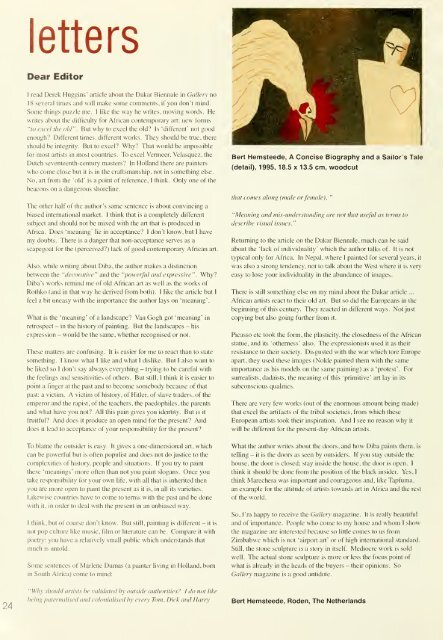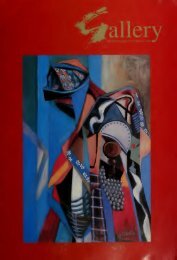Untitled - gallery delta
Untitled - gallery delta
Untitled - gallery delta
You also want an ePaper? Increase the reach of your titles
YUMPU automatically turns print PDFs into web optimized ePapers that Google loves.
letters<br />
Dear Editor<br />
I read Derek Huggins' article about the Dakar Biennalc in Gcillciy no<br />
1 8 several times and will make some comments, if you don't mind.<br />
Some things puzzle me. I like the way he writes, moving words. He<br />
writes about the difficulty for African contemporary art: new forms<br />
"to excel the old". But why to e.xcel the old? Is 'different' not good<br />
enough? Different times, different works. They should be true, there<br />
should be integrity. But to excel? Why? That would be impossible<br />
for most artists in most countries. To excel Vermeer. Velasquez, the<br />
Dutch seventeenth-century masters? In Holland there are painters<br />
who come clo.se but it is in the craftsmanship, not in something else.<br />
No, art from the old' is a point of reference, I think. Only one of the<br />
beacons on a dangerous shoreline.<br />
The other half of the author's .same sentence is about convincing a<br />
biased international market, I think that is a completely different<br />
subject and should not be mixed with the art that is produced in<br />
Africa. Does 'meaning' he in acceptance? I don't know, but I have<br />
my doubts. There is a danger that non-acceptance serves as a<br />
scapegoat for the (perceived?) lack of good contemporary African art.<br />
Also, while writing about Diba, the author makes a distinction<br />
between the "deconilive" and the "powerful and expressive" .<br />
Diba's works remind me of old African art as well as the works of<br />
Why?<br />
Rothko (and in that way he derived from both). I like the article but I<br />
feel a bit uneasy with the importance the author lays on "meaning'.<br />
What is the 'meaning' of a landscape? Van Gogh got 'meaning' in<br />
retrospect - in the hi.story of painting. But the landscapes - his<br />
expression - would be the same, whether recognised or not.<br />
These matters are confusing. It is easier for me to react than to state<br />
something. I know what I like and what I dislike. But I also want to<br />
be liked so I don't say always everything - trying to be careful with<br />
the feelings and sensitivities of others. But still, I think it is easier to<br />
point a finger at the past and to become somebody because of that<br />
past: a victim. A victim of history, of Hitler, of slave traders, of the<br />
emperor and the rapist, of the teachers, the paedophiles, the parents<br />
and what have you not? All this pain gives you identity. But is it<br />
fruitful? And does it produce an open mind for the present? And<br />
does it lead to acceptance of your responsibility for the present?<br />
To blame the outsider is ea.sy. It gives a one-dimensional art, which<br />
can be powerful but is often populist and does not do justice to the<br />
complexities of history, people and situations. If you try to paint<br />
these 'meanings' more often than not you paint slogans. Once you<br />
take responsibility for your own life, with all that is inherited then<br />
you are more open to paint the present as it is, in all its varieties.<br />
Likewise countries have to come to terms with the past and be done<br />
with it. in order to deal with the present in an unbiased way.<br />
1 think, but of course don't know. But still, painting is different - it is<br />
not pop culture like music, film or literature can be. Compare it with<br />
poetry: you have a relatively small public which understands that<br />
much is untold.<br />
Some sentences of Marlene Dumas (a painter living in Holland, born<br />
in South Africa) come to mind:<br />
" Why should artists be validated by outside authorities? I do not like<br />
r?^j<br />
Bert Hemsteede, A Concise Biography and a Sailor's Tale<br />
(detail), 1995, 18.5 x 13,5 cm, woodcut<br />
tluit comes alnni> (male orfemale). "<br />
"Meaning and mis-understanding are not that usefid as terms to<br />
describe visual issues."<br />
Returning to the article on the Dakar Biennale, much can be said<br />
about the 'lack of individuality' which the author talks of. It is not<br />
typical only for Africa. In Nepal, where I painted for several years, it<br />
was also a strong tendency, not to talk about the West where it is very<br />
easy to lose your individuality in the abundance of images.<br />
There is still something else on my mind about the Dakar article ...<br />
African artists react to their old art. But so did the Europeans in the<br />
beginning of this century. They reacted in different ways. Not just<br />
copying but also going further from it.<br />
Picasso etc took the form, the plasticity, the closedness of the Afncan<br />
statue, and its 'otherness' also. The expressionists used it as their<br />
resistance to their society. Disgusted with the war which tore Europe<br />
apart, they used these images (Nolde painted them with the same<br />
importance as his models on the same painting) as a 'protest'. For<br />
surrealists, dadaists. the meaning of this 'primitive' art lay in its<br />
subconscious qualities.<br />
There are very few works (out of the enormous amount being made)<br />
that excel the artifacts of the tribal societies, from which these<br />
European arti.sts took their inspiration. And I see no reason why it<br />
will be different for the present-day African artists.<br />
What the author writes about the doors, and how Diba paints them, is<br />
telling - it is the doors as seen by outsiders. If you stay outside the<br />
house, the door is clo.sed; stay inside the house, the door is open. I<br />
think it should be done from the position of the black insider. Yes. I<br />
think Marechera was important and courageous and. like Tapfuma.<br />
an example for the attitude of artists towards art in Africa and the rest<br />
of the world.<br />
So. I'm happy to receive the Gallery magazine. It is really beautiful<br />
and of importance. People who come to my house and whom I show<br />
the magazine are interested because so little comes to us from<br />
Zimbabwe which is not 'airport art' or of high international .standard.<br />
Still, the stone sculpture is a story in it.self. Mediocre work is .sold<br />
well. The actual stone .sculpture is more or less the focus point of<br />
what is already in the heads of the buyers - their opinions. So<br />
Gallery magazine is a good antidote.<br />
being paternalised and colonialised by every Tom, Dick and Harry Bert Hemsteede, Roden, The Netherlands







